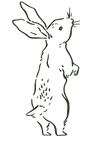
EU Regulations on Animal Research
Animal research in the European Union is conducted under the regulations of the Directive 2010/63/EU on the protection of animals used for scientific purposes.
It aims to put in action the 3R principles (replacement, reduction, refinement) and possibly to fully replace all animal research with non-animal alternatives, such as computer models and tissue engineering.
In 2013, the Directive was implemented into national laws in each of the EU Member States aiming to ensure high standards of animal welfare and scientific research.
Authorisation for animal use is given only in the presence of convincing scientific justification, when non-animal alternatives exist and expected benefits outweigh potential risks in terms of animal suffering.
As so, within the EU, limited animals are used for research purposes including basic and applied research into human and animal diseases, the protection of species and the environment, and education and training. As of 2013, animal testing for cosmetic purposes is banned.
The Commission's review of the Directive is currently underway.
Authorisation for Animal Research
All establishments require authorisation for animal research. Breeders, suppliers, and user of research animals rewuire seperate authorisation which is provided for a limited period of time. Renewal can be granted if the requirements of the Directive are sufficiently fulfilled.
Every research project has to be authorised before it's initiation and applications ought to contain a project proposal explaining sciientifically why animal research is unavoidable. The 3Rs must be considered when outlining the number of animals to be used and their expected suffering.
Each project proposal is evaluated by the "competent authority" (which is advised by a national committee for the protection of research animals) in each EU Member State.
The European Commission's Joint Research Centre focuses on research into developing and confirming non-animal methods. These ought to produce at least the same amount of information as the animal method, while using fewer or no animals and causing them less harm.
Procedures
Research procedures on animals can only be carried out as part of authorised research projects.
Severity of procedures is divided in the four categories of "non-recovery", "severe", "moderate", and "mild". All animals ought to be given local or general anaesthesia where appropriate, with the exception of it interfering with the goals of the research.
Such exceptions are not allowed in the case of severe procedures. In non-recovery cases, animals are put under full-anaesthesia and remain unconscious throughout the entire procedure.
When animals are no longer studied, procedures end. Animals are put back into their housing and they are continued being cared for. Humane euthanasia is allowed when their welfare is compromised because of the expected suffering to stay moderate or severe.
In such cases, the procedure is carried out by qualified experts using appropriate humane methods for each species.
Animals may be reused if their health and wellbeing have been fully restored.
Species
Depending on the nature of each research project, different species are selected. Researchers must select the species with the least capacity to experience pain and suffering, with which they can obtain expected results.
Additionally, they must report the origin of animals used in their research, with species like mice, rats, frogs, rabbits, cats, dogs, non-human primates and zebrafish being specifically bred for research purposes.
Stray or wild animals may only be used if the research objective is only obtainable with such animals.
Non-human primates are used solely for basic or specific medical research, or projects aimed at the preserving of the species.
Care for Research Animals
Animals used in research ought to be provided with species - specific housing, environmental enrichment, food, water and care to suit their health and overall wellbeing requirements. Any restrictions to animals' needs should be kept to a minimal and condtions should be recorded daily.
Staff involved in animal handling must be adequately trained before they are allowed to care for research animals or carry out any procedures. They must all work under supervision until they have demonstrated professional competence.
Equipment utilized must ensure efficient procedures with the least amount of harm, the minimum number of animals used and reliable results obtained.
Each EU Member State appoints specific authorities to carry out regular inspections of breeders, suppliers, users and the facilities provided by them. Such inspections can occur without warning.
